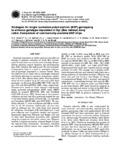Use este identificador para citar ou linkar para este item:
http://www.alice.cnptia.embrapa.br/alice/handle/doc/1036928| Título: | Strategies for single nucleotide polymorphism (SNP) genotyping to enhance genotype imputation in Gyr (Bos indicus) dairy cattle: Comparison of commercially available SNP chips. |
| Autoria: | BOISON, S. A.  SANTOS, D. J. A.   UTSONOMIYA, A. H. T.   CARVALHEIRO, R.   NEVES, H. H. R.   O'BRIEN, A. M. P.   GARCIA, J. F.   SÖLKNER, J.   SILVA, M. V. G. B.   |
| Afiliação: | S. A. Boison, University of Natural Resources and Life Sciences, Vienna, Austria; D. J. A. Santos, UNESP; A. H. T. Utsunomiya, UNESP; R. Carvalheiro, UNESP; H. H. R. Neves, UNESP; A. M. Perez O'Brien, University of Natural Resources and Life Sciences, Vienna, Aústria; J. F. Garcia, UNESP; J. Sölkner, University of Natural Resources and Life Sciences, Vienna, Aústria; MARCOS VINICIUS GUALBERTO B SILVA, CNPGL. |
| Ano de publicação: | 2015 |
| Referência: | Journal of Dairy Science, v. 98, n. 7, p. 4969-4989, 2015. |
| Conteúdo: | Genotype imputation is widely used as a cost-effective strategy in genomic evaluation of cattle. Key determinants of imputation accuracies, such as linkage disequilibrium patterns, marker densities, and ascertainment bias, differ between Bos indicus and Bos taurus breeds. Consequently, there is a need to investigate effectiveness of genotype imputation in indicine breeds. Thus, the objective of the study was to investigate strategies and factors affecting the accuracy of genotype imputation in Gyr (Bos indicus) dairy cattle. Four imputation scenarios were studied using 471 sires and 1,644 dams genotyped on Illumina BovineHD (HD-777K; San Diego, CA) and BovineSNP50 (50K) chips, respectively. Scenarios were based on which reference high-density single nucleotide polymorphism (SNP) panel (HDP) should be adopted [HD-777K, 50K, and GeneSeek GGP-75Ki (Lincoln, NE)]. Depending on the scenario, validation animals had their genotypes masked for one of the lower-density panels: Illumina (3K, 7K, and 50K) and GeneSeek (SGGP-20Ki and GGP-75Ki). We randomly selected 171 sires as reference and 300 as validation for all the scenarios. Additionally, all sires were used as reference and the 1,644 dams were imputed for validation. Genotypes of 98 individuals with 4 and more offspring were completely masked and imputed. Imputation algorithms FImpute and Beagle v3.3 and v4 were used. Imputation accuracies were measured using the correlation and allelic correct rate. FImpute resulted in highest accuracies, whereas Beagle 3.3 gave the least-accurate imputations. Accuracies evaluated as correlation (allelic correct rate) ranged from 0.910 (0.942) to 0.961 (0.974) using 50K as HDP and with 3K (7K) as low-density panels. With GGP-75Ki as HDP, accuracies were moderate for 3K, 7K, and 50K, but high for SGGP-20Ki. The use of HD-777K as HDP resulted in accuracies of 0.888 (3K), 0.941 (7K), 0.980 (SGGP-20Ki), 0.982 (50K), and 0.993 (GGP-75Ki). Ungenotyped individuals were imputed with an average accuracy of 0.970. The average top 5 kinship coefficients between reference and imputed individuals was a strong predictor of imputation accuracy. FImpute was faster and used less memory than Beagle v4. Beagle v4 outperformed Beagle v3.3 in accuracy and speed of computation. A genotyping strategy that uses the HD-777K SNP chip as a reference panel and SGGP-20Ki as the lower-density SNP panel should be adopted as accuracy was high and similar to that of the 50K. However, the effect of using imputed HD-777K genotypes from the SGGP-20Ki on genomic evaluation is yet to be studied. |
| NAL Thesaurus: | Beagle |
| Palavras-chave: | Imputation Gyr FImpute |
| Tipo do material: | Artigo de periódico |
| Acesso: | openAccess |
| Aparece nas coleções: | Artigo em periódico indexado (CNPGL)  |
Arquivos associados a este item:
| Arquivo | Descrição | Tamanho | Formato | |
|---|---|---|---|---|
| Cnpgl2015JDairySciStrategies.pdf | 2,02 MB | Adobe PDF |  Visualizar/Abrir |









